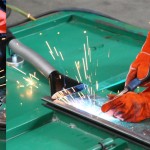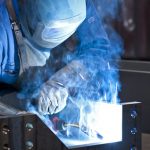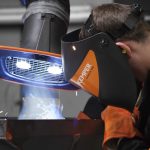Metal construction: The four most important occupational safety measures for welding
When it comes to occupational health and safety in metal construction companies, it is important to identify and eliminate a large number of potential dangers. One of the biggest sources of danger: Welding work and the pollutants it produces. Effective protective welding equipment with an individual mix of measures is the tool of choice to protect employees. The choice of appropriate measures depends on several factors.
Welding is and remains the most important joining process in the structural metal trade. The focus of activity in metal construction is the manufacture and assembly of products made of steel and/or aluminium, such as stairways, railings, canopies, balconies, gates, grilles or fences. But through welding work, hazardous substances that consist of particulate (welding fumes) and/or gaseous hazardous substances are released and have various harmful effects on health. In order to protect employees from the health hazards, it is recommended to use a mix of several measures that are adapted to the respective application.
Challenges in metal construction
When it comes to welding, metalworkers face huge challenges every minute of their working day. Errors in the welding process as well as in the corresponding protective welding equipment are not only expensive, but even endanger human lives. In the industry, this is due to the following circumstances in particular:
- Handling heavy construction materials and working with welding equipment increases the risk of accidents and damage to health in the metal construction industry. Usually, sheets and profiles with thicknesses of 3 to 25 mm are processed here, with dimensions of up to six metres.
- Due to the size and shape of the metal components, the workstations for welding are usually set up locally at changing workstations in the workshop. In some cases, metal products are only finally assembled and welded together at the construction site.
- In metal construction, conventional fusion welding (LBW, MIG/MAG and TIG) is the most important. The main focus is on MAG welding process (metal active gas welding) of non-alloyed steels, which has a high to very high hazard potential. With MIG (metal inert gas welding) and TIG (tungsten inert gas welding), an invisible hazardous substance is produced: Ozone.
- In addition, some metalworking companies also process stainless high-alloy steel materials. Welding produces the most dangerous pollutant particles that are even carcinogenic and make the use of extraction technology all the more indispensable.
The four most important occupational safety measures in metal construction
Due to the numerous sources of danger in metal construction, measures are necessary to protect the health of employees. The possible hazards in welding are essentially determined by the process used and the specific working environment. These factors must be taken into account when determining the hazard.
Generally, it is also important to check whether welding can be replaced by other joining methods such as gluing, seaming or mechanical joining. When selecting the welding process, lower-pollution processes (TIG instead of LBW or MAG solid wire instead of MAG cored wire) should be used whenever possible. Following the so-called STOP principle, the first step would be substitution, i.e. the exchange of processes or materials, although this is not always possible: The use of effective welding fume extraction is therefore of great importance in the order of priority as the second measure in all processes.
1) Torch-integrated extraction system
In metal construction, the welding fumes should be captured at the point of origin if possible. The closer the extraction is to the point of origin, the more efficient the capture of the hazardous substances. Extraction torches were long considered unpopular with welders simply because of their weight. Today’s modern systems are much easier to handle and offer numerous useful additional functions that make welding work much safer and more comfortable.
With long weld seams, the torch-integrated extraction is particularly suitable. This type of extraction collects hazardous substances directly at the welding torch, just above the shielding gas nozzle.
2) Source extraction using mobile devices
As an alternative to torch-integrated extraction, source extraction with exhaust arms is also used for welding in the metal construction industry. The exhaust arms offer a high degree of flexibility in welding fume extraction and can easily be adjusted during the work process. Thanks to integrated LED lighting, the welder also has a better view of the components.
3) General ventilation measures and spatial separation
As an additional ventilation measure, a general ventilation system may also be required to ensure compliance with the limit values for employees at the surrounding workplaces, who do not perform welding work but are exposed to welding fumes and gases. Contaminated air is extracted here at a height of three metres, cleaned and reintroduced at ground level. Third parties are also protected by spatial separation of the welding workshop and other production areas.
4) Personal protection measures
If welding fume extraction is insufficient or implementation is generally technically impossible, the employer must provide suitable equipment to protect metal construction welders. For example, the following respiratory protective devices can be used to protect against the welding fumes:
- Ventilated helmets or hoods
- Masks with blower and particle filter
- Full face masks or mouthpiece sets
- Self-contained respirator devices (e.g. ventilated helmets/hoods with external air supply)






